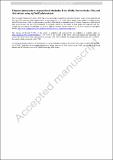| dc.contributor.author | Alaskary, Saddam A. | |
| dc.contributor.author | El-Shahat, M. F. | |
| dc.contributor.author | Ahmed, M. A. | |
| dc.contributor.author | Elmahgary, Maryam G. | |
| dc.date.accessioned | 2025-06-13T20:43:11Z | |
| dc.date.available | 2025-06-13T20:43:11Z | |
| dc.date.issued | 2024-06-12 | |
| dc.identifier.uri | https://hdl.handle.net/1721.1/159415 | |
| dc.description.abstract | AgI/SnO2 composites, synthesized via sol–gel method, emerge as highly efficient photocatalysts for degrading rhodamine B (RhB), fluorescein (Flu), and their mixtures, shifting photocatalytic activity into the visible spectrum. Characterized by XRD, FESEM, DRS, EDX, mapping, TEM, BET, and XPS, these nanocomposites, especially with 15% AgI, show a remarkable increase in photocatalytic efficiency for Flu, achieving a rate constant of 0.0189 min−1 which is triple that of pure SnO2 at 0.0061 min−1. The optimal degradation of Flu, RhB, and their mixture occurs with 0.1 g of the 15 wt% AgI/SnO2 composite. This enhancement is attributed to the Z-scheme mechanism facilitated by the small energy gap between AgI and SnO2 conduction bands, effectively minimizing electron–hole recombination and boosting photocatalytic performance through the generation of superoxide and hydroxyl radicals. These findings position AgI/SnO2 composites as promising candidates for treating both cationic and anionic dye pollutants. | en_US |
| dc.publisher | Springer International Publishing | en_US |
| dc.relation.isversionof | https://doi.org/10.1557/s43580-024-00883-4 | en_US |
| dc.rights | Creative Commons Attribution-Noncommercial-ShareAlike | en_US |
| dc.rights.uri | http://creativecommons.org/licenses/by-nc-sa/4.0/ | en_US |
| dc.source | Springer International Publishing | en_US |
| dc.title | Enhanced photocatalytic degradation of rhodamine B dye (RhB), fluorescein dye (Flu), and their mixture using AgI/SnO2 photocatalyst | en_US |
| dc.type | Article | en_US |
| dc.identifier.citation | Alaskary, S.A., El-Shahat, M.F., Ahmed, M.A. et al. Enhanced photocatalytic degradation of rhodamine B dye (RhB), fluorescein dye (Flu), and their mixture using AgI/SnO2 photocatalyst. MRS Advances 9, 1196–1206 (2024). | en_US |
| dc.contributor.department | Massachusetts Institute of Technology. Department of Chemical Engineering | en_US |
| dc.relation.journal | MRS Advances | en_US |
| dc.eprint.version | Author's final manuscript | en_US |
| dc.type.uri | http://purl.org/eprint/type/JournalArticle | en_US |
| eprint.status | http://purl.org/eprint/status/PeerReviewed | en_US |
| dc.date.updated | 2025-03-27T13:50:49Z | |
| dc.language.rfc3066 | en | |
| dc.rights.holder | The Author(s), under exclusive licence to The Materials Research Society | |
| dspace.embargo.terms | Y | |
| dspace.date.submission | 2025-03-27T13:50:49Z | |
| mit.journal.volume | 9 | en_US |
| mit.license | OPEN_ACCESS_POLICY | |
| mit.metadata.status | Authority Work and Publication Information Needed | en_US |
